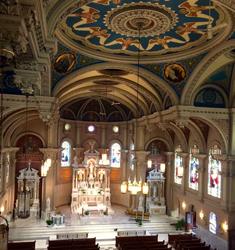
Schantz Organ Company announces the start of a project for St. Bernard Catholic Church, Akron, Ohio.
Removal of this III/39, originally built by Schantz in 1905 for the then new church building occurred the first week of June. In its original configuration, the organ had mechanical key action and tubular-pneumatic stop action and offset chests. Schantz returned to the church in 1916 and 1926, when the organ was converted to all tubular-pneumatic action. In the 1950s, a local builder provided all new electro-pneumatic action and a supply-house console with relay.
The present work includes the complete rebuilding of the 1950s windchest mechanisms, slight layout modifications, a new console and relay, a thorough rebuilding of the 1905 pipework (including the facade), a new Swell Mixture, and a new Great/Pedal 16′/8′ Trumpet.
The organ is located high in the second gallery of this historic ecclesiastical edifice. The accompanying photograph is looking down the nave from the organ gallery.
For information: www.schantzorgan.com.


